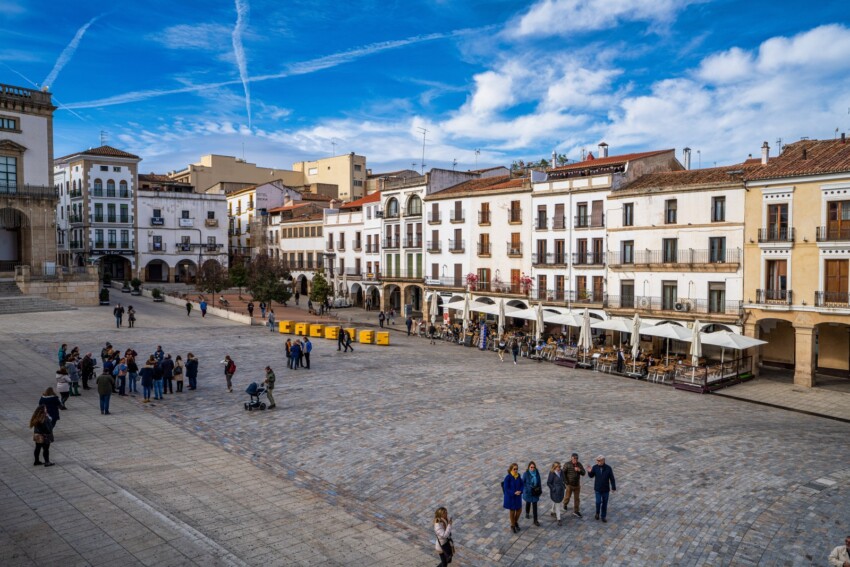

Cáceres is a fantastic town in west-central Spain, rising 430 metres above sea level, between the Sierra de la Mosca and the Serrilla. The old city (or Ciudad Monumental) is still enclosed within its walls and preserves numerous testimonies not only of Spanish and Italian Renaissance architecture but also of Gothic.
The city was founded in 25 B.C. by the Roman consul Lucius Cornelius Balbo under the name of Norbensis Caesarina and the construction of the road, today known as the Ruta de la Plata, which connected the cities of Gijon and Seville, dates back to that time.
Cáceres was later dominated by the Arabs and Christians, two civilisations that left an enormous architectural and historical legacy. It was not until the 13th century that King Alfonso IX definitively freed the city from the Arabs and incorporated it into the Kingdom of León.
The fact that Cáceres has managed to preserve the ancient urban layout and many testimonies of the different dominations that have succeeded one another made it possible for it to be declared a UNESCO World Heritage Site in 1986.
The town of Cáceres is an intricate maze of cobbled streets and squares surrounded by elegant palaces. This destination is not often included on traditional tourist itineraries, so walking around its centre is like taking a trip back in time. Alongside historic churches and old buildings are shops, small boutiques and restaurants where you can sample the local gastronomy.
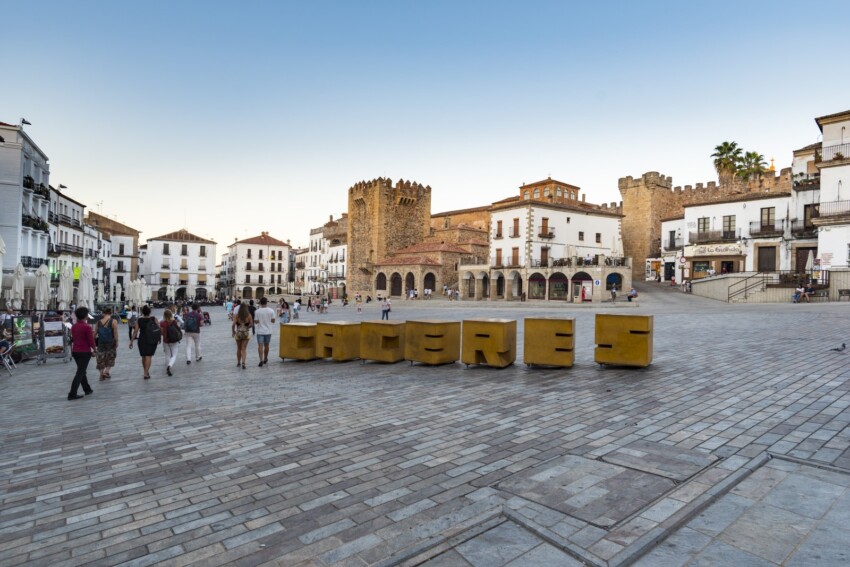
The ‘Ciudad Monumental‘ (monumental city) of Cáceres is the oldest area of the city and is the one preserved within the city walls. Here you will find the main sites of interest, numerous restaurants and shops. The part outside the walls is the most modern and built in more recent times.
The city is divided into four parishes, Santa María, San Mateo, Santiago and San Juan. Of these, the first two are inside the wall, while the last two are outside. In addition to being a UNESCO World Heritage Site, the ‘Monumental City of Cáceres‘ was declared Europe’s Third Monumental Complex by the Council of Europe (after Prague and Tallinn).
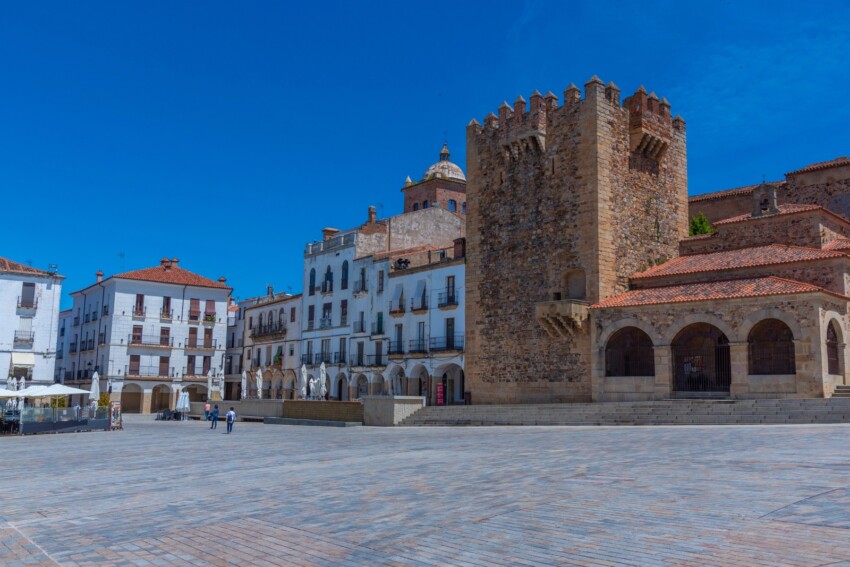
Plaza Mayor is the city’s main square and traditional meeting point. The Plaza Mayor of Cáceres is considered one of the largest squares in Spain and currently houses numerous bars, restaurants, arcades with shops and the Town Hall. Originally, the square was built in the 12th century to hold an annual fair, but it was later preserved first as a site for the city market and later as a meeting place.
In the 15th century, the construction of elegant palaces, buildings and arcades supported by stone pillars and round arches began. Inside the square you can admire the remains of the Bujaco tower, the Púlpitos tower and the Grass tower. One of the most important gateways to the square is the Arch of the Estrella, rebuilt by Manuel de Lara Churriguera in the 18th century. From this square starts Calle Pintores, the most commercial street in Cáceres.
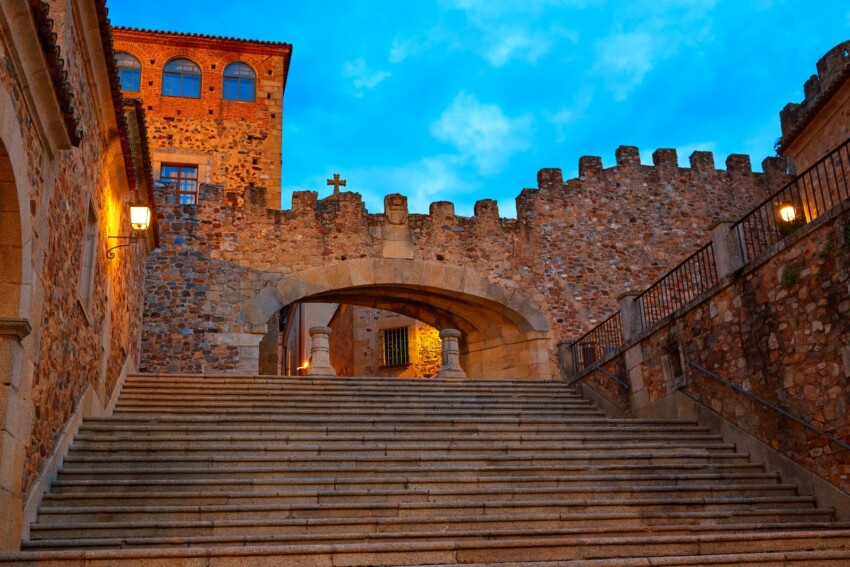
The Arco de la Estrella is considered the main entrance gate to the Monumental City of Cáceres. Built in the Baroque style, the gateway currently connects Plaza Mayor with Plaza de Santa María, two nerve centres of the city. Located next to the Bujaco Tower, the arch was erected in the 15th century in place of an earlier entrance, but underwent a major renovation in the 18th century by Manuel de Lara Churriguera. This large oblique arch currently houses a statue of the Virgen de la Estrella (Our Lady of the Star) on the inside, which gives the arch its name, while on the outside is the coat of arms of Cáceres.
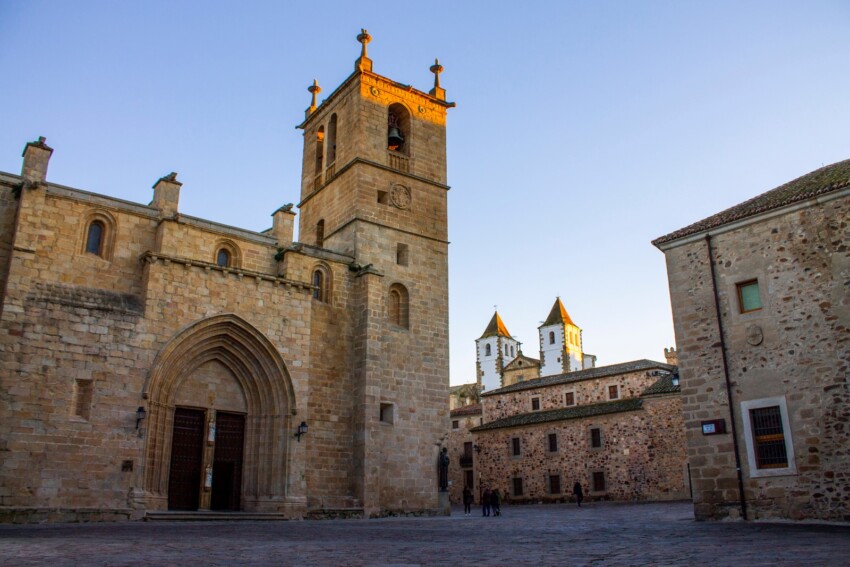
The Co-Cathedral of St. Mary Major was built between the 15th and 16th centuries on the site of an earlier 13th century building in the Mudejar style. This place of worship was later rebuilt in Gothic style (mixed with the previous Romanesque) with three naves. With a rectangular floor plan, the church internally boasts naves separated by cruciform pillars with ogival arches and Gothic vaults.
The Co-cathedral houses a 16th-century altarpiece dedicated to the Assumption of the Virgin, which was made by Roque Balduque and Guillén Ferrant from pine and cedar wood in the Extremaduran style. The façade is flanked by a tower housing a statue of St. Peter of Alcántara created in 1954 by sculptor Enrique Pérez Comendador.
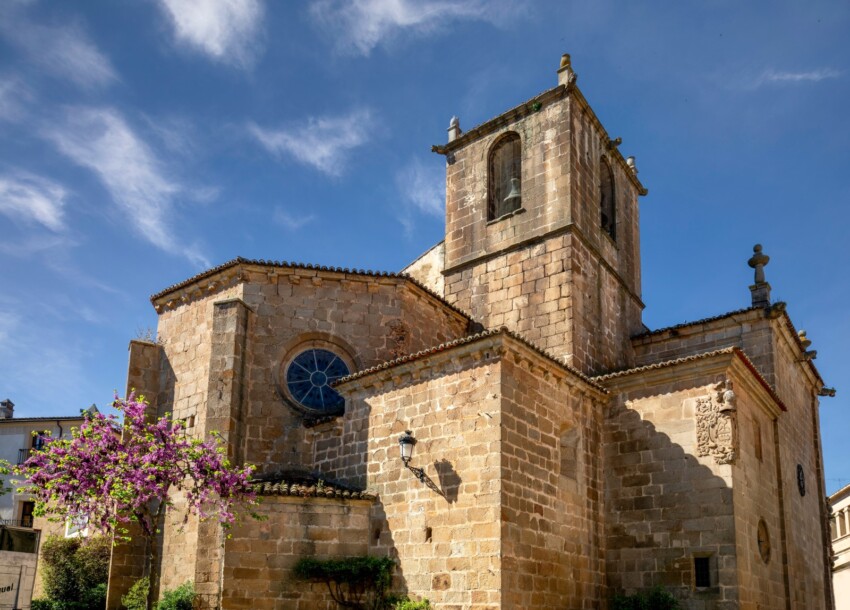
At one time, this was the area of the city that welcomed the transhumant cattle breeders who visited Càceres and stayed in this area when the cattle fairs were held. The Church of San Juan therefore originated as a place of worship for the cattle breeders. The building, constructed in the 13th century, underwent major alterations in the following centuries and had therefore lost much of its original layout. In the 20th century, however, restoration work brought some of its native style back to the church.
Inside, there are several chapels, including the Chapel of Relics, which boasts a roof decorated with cherubs and balustraded columns on either side. The church is located in an area full of bars, restaurants and tapas bars where you can sample excellent Extremaduran cuisine.
This complex, which occupies a large space in the historical centre of the city, consists of the Church of San Francisco and the College built by the Society of Jesus in the 18th century.
The church has a single nave with side chapels, a dome over the transept and houses a canvas by the Neapolitan painter Paolo de Matteis. The façade has a niche housing the image of San Francisco Javier and is flanked by two square white towers.
The college built in Baroque style with Churrigueresque influences currently houses the Exhibition Palace and the territorial delegation of the Department of Culture and Heritage of the Extremadura Region.
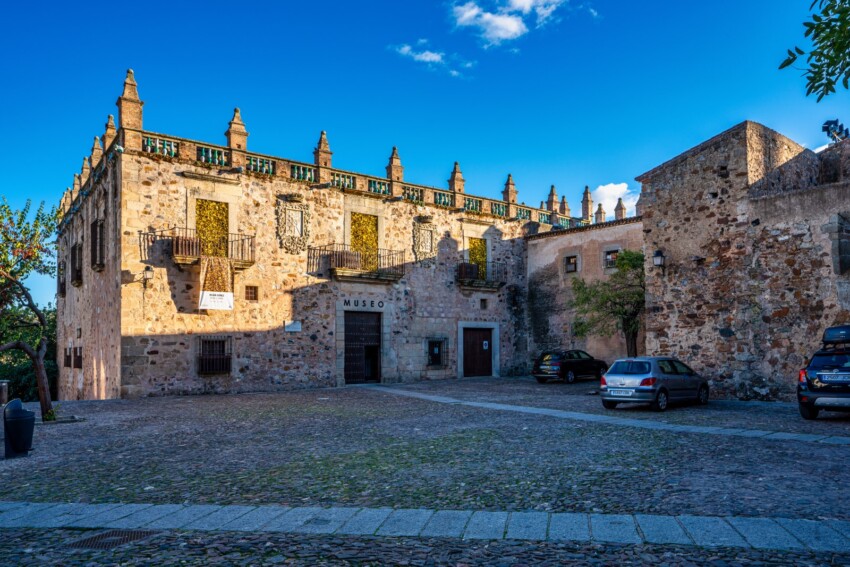
The Museum of Cáceres houses numerous archaeological and cultural testimonies of the province’s history, ranging from the Palaeolithic to avant-garde and contemporary art. The museum is currently housed in two interconnected buildings: the House of the Veletas and the House of the Caballos.
The route inside is divided into three main sections: Archaeology, Ethnography and Fine Arts. Of particular note are the Bronze Age stone stelae, oriental artefacts, Roman mosaics and a collection of 20th century Spanish art.
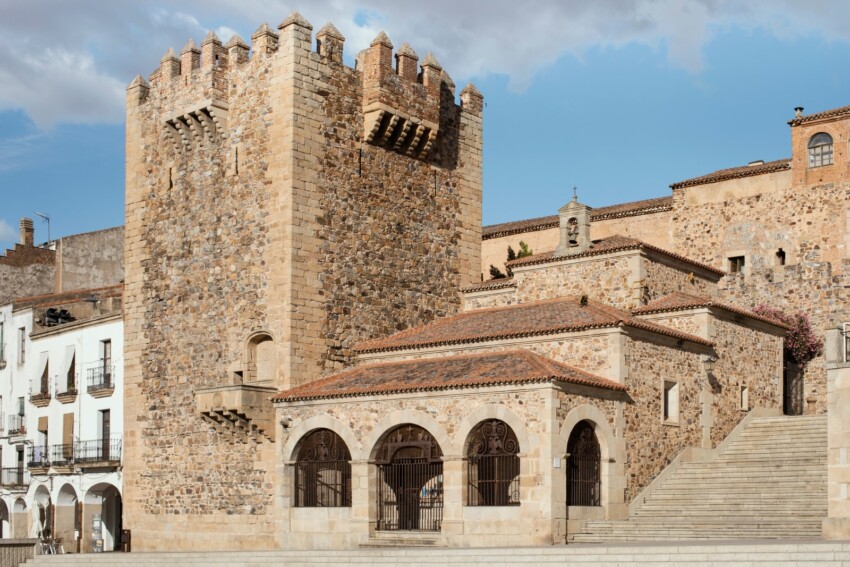
Built during Arab rule, the Bujaco Tower owes its name to Caliph Abú-Ya’qub who conquered the city in 1173 after months of siege. For a time, it was also known as the Clock Tower because, from the end of the 16th century to the end of the 18th century, a clock was installed here for commercial activities in the area.
The tower, approximately 25 metres high, has a crenellated top and a square plan with two side parapets and a front one that was only added in the 18th century. From up there, it is possible to admire a beautiful panorama of the entire city.
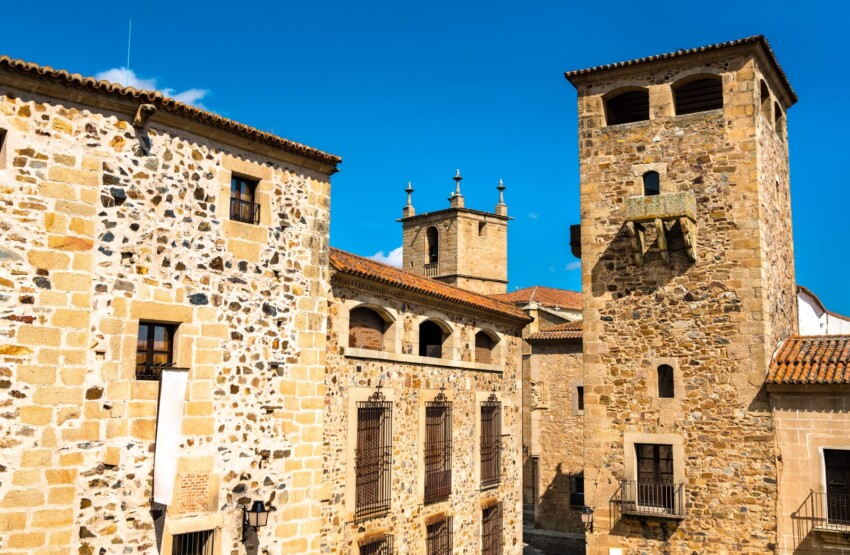
The Golfines de Abajo Palace was originally commissioned by King Enrique IV, although it later became the property of the Golfines family until the death of the last descendant, Doña Tatiana Pérez de Guzmán VIII Countess of Torre Arias.
This majestic palace has a Gothic structure, 17th-century Plateresque decorations and was built following the architectural canons of the 15th-century house-fortress. On the outside, two towers of different sizes flank the façade, which features a round arch with coats of arms.
Inside, the palace has now been converted into a museum but has retained its appearance as a nobleman’s house with large halls and valuable furnishings. Here you can not only learn about the history of Cáceres but also about different aspects of the evolution of noble families over time: their tastes, beliefs, trends and fashions.
In the following map you can see the location of the main places of interest mentioned in this article.
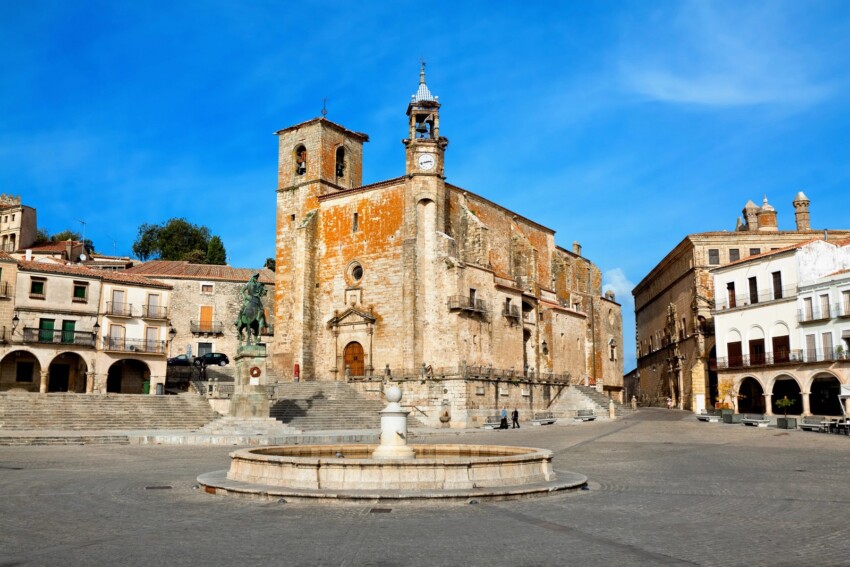
The location of Cáceres makes it easy to explore some of the most interesting areas of Extremadura. Renting a car is recommended for maximum flexibility.
The Monfragüe National Park, 50 km from Cáceres, is one of the most important natural spaces in Spain. This park is renowned for its population of black vultures and imperial eagles. Visitors can explore marked trails, watch birds of prey and enjoy spectacular views from the ancient fortifications.
The historic city of Trujillo, 45 km from Cáceres, is famous for its Renaissance palaces and for being the birthplace of several conquistadors. The Plaza Mayor, with the equestrian statue of Francisco Pizarro, and the medieval castle are the main attractions. The city is also known for its gastronomy, in particular its goat cheese.
The Monastery of Guadalupe, a UNESCO World Heritage Site, is located 120 km from Cáceres. This impressive monastic complex combines Gothic, Mudejar, Renaissance and Baroque styles. The monastery houses the image of the Virgin of Guadalupe, patron saint of Extremadura.
The city of Plasencia, 80 km from Cáceres, offers an interesting historical centre with two cathedrals (old and new) and numerous noble palaces. The city is also a good starting point for exploring the Valle del Jerte, famous for its cherry blossom in spring.
Cáceres is a pleasant town with a small but interesting historical centre on a human scale. The city is now famous as a UNESCO World Heritage Site. Sleeping in the Ciudad Monumental area is definitely the best option because it allows you to fully experience the atmosphere of the city and to be close to the main sites.
In the centre you can find not only several hotels but also small inns and family-run establishments that are really cosy. Bear in mind that some accommodation may be located in converted historical buildings that can give a different and original touch to your stay.
Cáceres can be easily reached by car or by public transport. For those travelling by car, the city is connected via the A-66 (former Roman road of La Plata) with Hervás, Plasencia, Mérida, Fuente de Cantos and Salamanca. Those coming from Madrid can reach it via the A-58, which also passes through Trujillo.
Cáceres is also well connected with Portugal via the N-521. The city has a railway station with connections to nearby cities such as Mérida, Plasencia, Badajoz but also to places further afield such as Madrid and Seville.
What's the weather at Cáceres? Below are the temperatures and the weather forecast at Cáceres for the next few days.
Cáceres is a town inExtremadura, an Autonomous Community located in the west of Spain. The city is 300 km from Madrid, 200 km from Salamanca and 265 km Toledo.